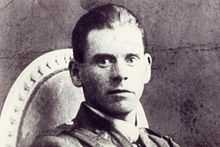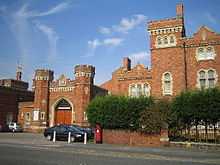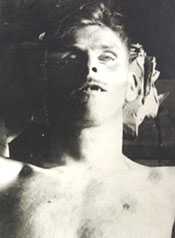Percy Toplis

Francis Percy Toplis (20 August 1896 – 6 June 1920) was a British criminal and imposter active during and after the First World War. Before the war he was imprisoned for attempted rape. During the war he served as a private in the Royal Army Medical Corps, but regularly posed as an officer while on leave, wearing a monocle. After the war he became notorious following the murder of a taxi driver and the wounding of a police officer who attempted to apprehend him. The subsequent manhunt was major news at the time. He was tracked down and was killed in a gunfight with police.
In 1978 a book was published which claimed that he took a major part in the Étaples Mutiny from 9–12 September 1917, as "The Monocled Mutineer", during the war. The authors suggested that he was subsequently pursued by the political establishment in a vendetta, and may have been innocent of the murder. The book was dramatised by the BBC in 1986 as The Monocled Mutineer, creating considerable controversy.
Critics say that there is no evidence he was actually present, and official records show that Toplis' regiment was en route to India during the Étaples mutiny. No evidence exists to show that Toplis was absent from his regiment. However, neither is there evidence that Toplis ever went to India. He may only have got as far as Malta. It is now believed that it is highly unlikely that he returned to Europe in time to participate in the mutiny.[1]
Birth and Youth

Toplis was born at 30 Carr Lane, South Normanton,[2] near Alfreton, Derbyshire and christened on 25 September 1896 at Skegby. His parents, Herbert and Rejoice Elizabeth (née Webster), were unable to support him and he was raised by his grandparents.
He was educated at South Normanton Elementary School, where he was reportedly an unruly bully who was frequently caned.[2] In March 1908, aged 11, he was birched for acquiring two suits using false pretences. His grandparents were no longer able to control him and the court released him to his aunt, Annie Webster. Toplis left school in 1910, aged 13, and became a blacksmith's apprentice at the Blackwell colliery, but after a poor attendance record and an argument with the pit manager he took to an itinerant life in Scotland. In 1911 he was sentenced to ten days imprisonment in Dumfries for the non-payment of two train tickets. He returned to England, and in 1912, aged 15, he was sentenced to two years hard labour for the attempted rape of a 15-year-old girl at Mansfield, serving sentence in Lincoln Prison.[2] He was released in 1914.
First World War
In 1915, the year after the outbreak of the First World War, Toplis volunteered to enlist in the Royal Army Medical Corps, where he served as a stretcher bearer, his first active duty being at Loos. His unit was shipped to the landings of Gallipoli, and when they returned Toplis was hospitalised for dysentery. Afterwards he briefly worked in a munitions factory. His unit was later posted to fronts in Salonika and Egypt, but he was sent back when he contracted malaria. In September 1917 his unit was shipped to Bombay for some months and then returned to Britain.
He made a public revisit to Blackwell posing in the uniform of an army Captain. The visit and some of his anecdotes were reported by local newspaper, the Nottingham Evening Post, who took a photograph (shown in this article) that they later released to the police for his 'wanted' notice in 1920.[2]
In August 1918 Toplis' father died. Soon afterwards he deserted from Blackpool. He was sentenced at Nottingham Assizes to two years in prison for fraud. When released in 1920, he joined the Royal Army Service Corps, and was stationed in Bulford. He was soon selling rationed fuel on the black market, forging false papers to gain access to other soldiers' salaries, and wearing a colonel's uniform when he visited women in town. He often used a gold monocle as part of his disguise.
Murder and pursuit
Toplis went AWOL again on 24 April 1920. After 9.00 p.m., taxicab driver Sidney George Spicer was found dead from a gunshot wound on Thruxton Down, near Andover. Toplis was seen in Bulford Camp around 11.00 p.m. The inquest into George Spicer's death took place in a barn on Thruxton Down. The jury returned a verdict of 'wilful murder' by Percy Toplis, foreshadowing the possibility of his execution when caught; it was the first British inquest in modern times to declare a man guilty of murder in his absence.
Toplis spent the next couple of weeks in London posing as an officer. The police began to close in, and he fled to Monmouth, Wales, and eventually to Tomintoul, Scotland. On 1 June a farmer near Tomintoul saw smoke in a lone gatekeeper's bothy. He alerted Police Constable George Greig, and together they found Toplis sitting by a fire. Toplis fired his pistol, wounding them both and then fled on a bicycle. He cycled to Aberdeen and took a train to Carlisle, where he arrived on 5 June. He was seen in an Army base in Carlisle Castle.

On 6 June, in Cumberland, Police Constable Alfred Fulton met and questioned a man in "partial military dress" but let him go. Back at the station, he checked police circulars and noticed that this man matched the description of a man suspected of the Andover murder. He went back to apprehend Toplis, but retreated when Toplis threatened him with a Webley Mk VI revolver.
Two other policemen, Inspector William Ritchie and Sergeant Robert Bertram, joined Fulton. Ritchie and Bertram were armed with Webley revolvers and had also disguised their uniforms. It is believed that this may have been the result of orders from the Home Office to the Chief Constable Norman de Courcy-Parry. They set off by car to apprehend Toplis and were joined en route by the chief constable's civilian son, Norman de Courcy-Parry, Jr., on his 1000-cc motorcycle. Parry was armed with a Belgian automatic pistol, which he had brought back as one of a number of firearms, 'unofficial souvenirs' from the war. They saw Toplis but did not recognise him until they had passed him and were some yards down the road. After quickly turning the car round, the group again approached Toplis. Norman de Courcy-Parry stopped the car, feigning mechanical trouble. He exited, pretending to check the trouble, as Toplis approached. The police officers then came out and challenged Toplis, who attempted to flee and fired at them. The officers ran towards him shooting, and Toplis fell dead.[3]
An inquest was held on 8 June. The next day, Toplis was buried in an unmarked grave near the top of Penrith's Beacon Edge Cemetery. Toplis' belongings, including his monocle, were handed to Penrith Museum. Despite plans by Canadian, Frank Dayson, a childhood friend of Toplis, to erect a headstone on the grave in 1980, as of 2012 Toplis' grave remains unmarked.
Alleged mutineer
In 1978 William Allison and John Fairley published The Monocled Mutineer,[4] in which they portray Percy Toplis as a leading participant in the Étaples Mutiny as a consequence of his being among a band of deserters based in that area of France. They say that Toplis was sought in France following the mutiny and posters for his arrest were issued. The fact that the British authorities went to such lengths to apprehend or silence Toplis is thought by Allison and Fairley to add credence to the view that he was one of the only leaders of the mutiny that escaped the retribution that immediately followed.
After the book was published, Toplis's supposed career as a mutineer was dramatised by Howard Barker in his 1980 play Crimes in Hot Countries, in which he is portrayed as an irrepressibly subversive seducer, "irresponsible and amoral, with little concern as to the consequences of his action for others".[5] The 1986 BBC series entitled The Monocled Mutineer, an adaptation by Alan Bleasdale of the book[6] in which Toplis was played by Paul McGann, portrayed him in a much more positive light.[7] The production fuelled accusations by the Conservative government of the time of left-wing bias at the BBC. The British right-wing press denounced the accuracy of the series and the book on which it was based.[7]
Official records show that Toplis' regiment was en route to India during the Étaples mutiny. No evidence exists to show that Toplis was absent from his regiment. However, neither is there evidence that Toplis ever arrived in India, as the last recorded reference to him places him in Malta. He was a deserter and regularly moved between regiments masquerading as an NCO or an officer in order to get food, win money from gambling and for accommodation.
It is possible that information about any involvement by Percy Toplis in the mutiny by soldiers in the training camp known as The Bull Ring at Étaples will be made clearer in 2017 when the official files regarding the mutiny are scheduled to be released into the public domain by the UK's National Archives. This, however, is unlikely as all the records of the Étaples Board of Enquiry have been destroyed long since.
Books
- William Allison & John Fairley: The Monocled Mutineer (1978)
- Edwin T Woodhall: Detective and Secret Service Days (N/K)
References
- ↑ Kelbie, Paul (12 February 2006). "The Monocled Mutineer is innocent". The Independent.
- ↑ 2.0 2.1 2.2 2.3 Bates, Tom (31 May 2007). "Percy Toplis - The Monocled Mutineer.". Tom Bates.
- ↑ Penrith Museum, biography and photograph
- ↑ Allison, William; Fairley, John (1978). The Monocled Mutineer. Quartet Books. ISBN 07-0432-154-8.
- ↑ Charles Lamb, The Theatre of Howard Barker, Routledge, New York, 2004, p.62.
- ↑ Bleasdale, Alan; Allison, William; Fairley, John (1986). The Monocled Mutineer. Hutchinson. ISBN 00-9168-671-7.
- ↑ 7.0 7.1 Hanna, Emma, The Great War on the Small Screen: Representing the First World War in Contemporary Britain, Edinburgh University Press, 2009, pp.120ff.
External links
|